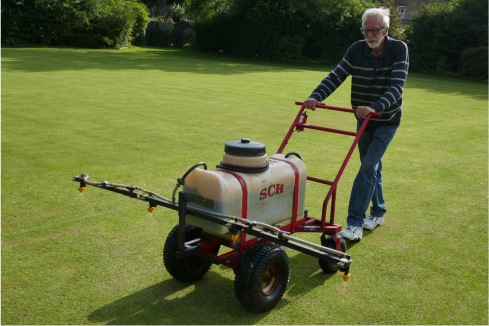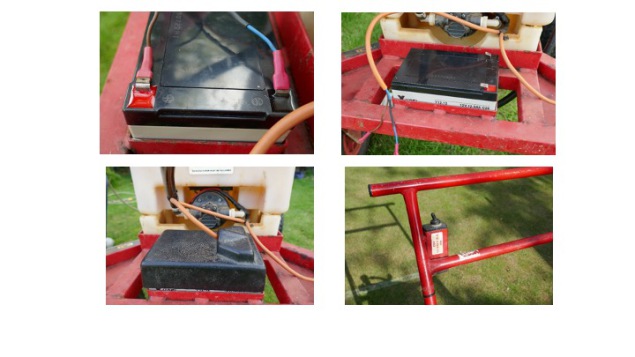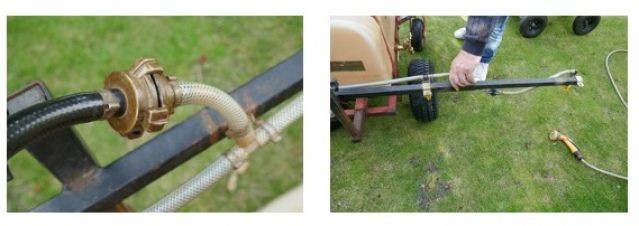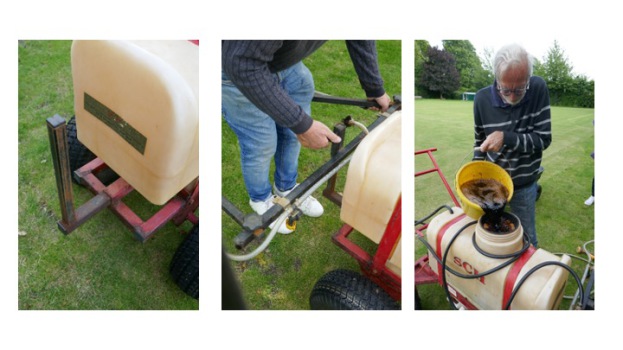Spraying
Our SCH Sprayer has a capacity of 65 litres and is stored at the back of ‘Frank’s Shed’ on the right. Ensure the tires are pumped and that the battery is fully charged prior to all operations and that the battery connections have been correctly made: Blue to Black and Brown to Red. The battery cover should also be affixed. Also check the equipment was properly cleaned of any previous chemicals used. Check the flow and spread of the 4 sprayer nozzles on a test run using just water prior to adding chemicals to the mix.
When connecting the liquid pipe to the sprayer arm DO NOT FULLY TIGHTEN because if you do so it is an absolute pain to separate again (see photo below). When connecting the sprayer arm which unfolds, ensure that the height is set, such that it allows for 4 conical shaped flows of liquid spray which should just overlap each other but are not too high that the spray is dispersed by any wind.
Depending on the chemicals to be used safety clothing, gloves, safety glasses and or masks may be required and are available in the hut. Old and waterproof footwear is desirable and long sleeves are always advised. The lawns must be switched prior to spraying.
A battery (disconnected) may be found on the sprayer, a spare battery is kept in the middle drawer of the three drawer unit in the main room on the far wall. Spare nozzles may be found in the brown case. There is a measuring mug for chemicals currently found in the yellow bucket together with a glass measuring jug and stirer. A full yellow bucket (in the hut) holds 10 litres. We have a trickle charger (stored aforementioned three drawer unit) for recharging batteries. This may also be used to check how fully charged a battery is.
A fully charged battery is generally sufficient for three lots of fifty litres with some still to spare, it was not sufficient for six lots of fifty litres when the iron sulphate was sprayed on a previous occasion.
Never spray in high winds and be aware of potential wind speeds when planning a spraying session. Anything over 8-9 miles per hour may prove to be problematic. Wind greatly effects the evenness and accuracy of the spraying but the wind-blown spray itself may also prove harmful to any individual pushing the machine.
Measures and volume of water required varies with each specific operation. Carefully check the requirements and required measures following any written instructions explicitly. Double check the measures. Most operational quantities work roughly for the spraying of one lawn area per full, or relatively full, tank.
A regular and moderate walking speed ensures an even spread. To aid walking in straight lines an accomplice directing your line of travel at the far end of the lawn is very useful, otherwise pinpointing a fixed object to head for is also useful in maintaining straight lines. Once under way observations of previous wheel tracks come into their own. It is easier to push the fully laden sprayer from east to west to avoid the slope on lawns 2 & 3.
A simple on off switch (see photo) starts the pump, turn on when already in motion. Once underway ALWAYS TURN OFF THE SPRAYER BEFORE STOPPING. To do otherwise sprays excessive amounts of any chemicals spayed on a single spot and may well damage the lawns.
Example of spraying specifications: WEEDOL 82 Litres. 42 Litres per half lawn (twice) to 1.2 Litres of Weedol which frothed up when added to water. This amounts to just over 40 Litres water to 600 ml of Weedol, not possible to be 100% precise due to foaming in the sprayer. Approximately 820 square metres per lawn
Example: Spray 30 Litres 20 0 10 Liquid Biofeed, Humic, Seaweed – 10L in 40L water per lawn
When completed the sprayer tank and nozzles should be flushed clean and all equipment used returned to their various locations. Other than the components of the sprayer itself you will require: a hose to be connected to the water supply, the long-handled spanner key (turns the water on/off), a long metal or wooden stirring implement (there is one kept near the water supply, possibly buckets and possibly the measuring jug.
This factsheet provides details of preparation and steps needed to undertake spraying.
Spraying (March 24).pdf
Adobe Acrobat document [46.5 KB]
GUIDANCE FOR HANDLING chemicals and lawn[...]
Microsoft Word document [14.7 KB]






